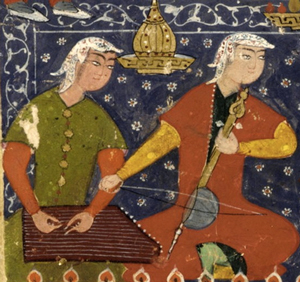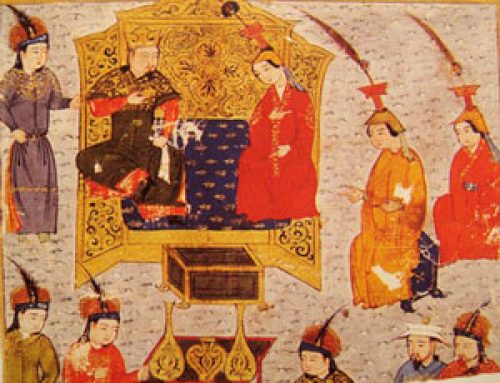Chinese woman playing an erhu: early bowed instruments
Plucking a hunting bow to make music
Central Asia was the place where people invented the ancestors of violins and cellos. Siberian or Mongolian people made the first bowed instruments. Because lots of people all over the world used bows and arrows, the first stringed instruments were bows.
Early bows and arrows
Early African music
History of music
All over the world, people used bows as musical instruments by plucking the strings, probably as early as the Stone Age. Gradually people added sound boxes to make the bows louder, and the bow as a musical instrument turned into the ancestors of guitars, like the ngoni in Africa.

A Safavid man plays a kamanche with a bow (1560 AD)
Bowed instruments and the Khitan
As the Liao Dynasty, the Khitan ruled northern China in the 900s AD, and the Song Dynasty emperors paid them tribute in gold. Some time before that, the Khitan had shifted from using bamboo sticks as bows to using wooden bows strung with hanks of horsehair, like modern violin bows. This was like rubbing one hunting bow against another, and maybe that’s how it got started.
Song Dynasty China
Music in China
The Khitan rode horses all the time, so they had lots of horsehair. Even today, a musical bow still uses between 150 and 200 hairs from the tail of a horse, and the best bows use the thicker hair from horses native to colder, northern climates. Thicker hair gives a better grip on the strings. The tails of Mongolian horses were just right. And horsehair bows still use rosin; they won’t grip the strings enough to work without it.
Bowed instruments and the Sassanians
It’s possible that these early bowed instruments reached the Sassanian Empire under Khosrau II, about 600 AD. People said that there were great musicians in Khosrau II’s kingdom, and maybe that’s because they had the new bowed instruments.





